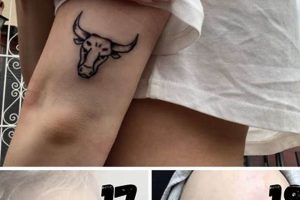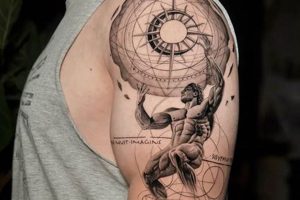Conceptualizing and sketching potential body art designs constitutes a crucial initial phase in the tattooing process. This involves researching various styles, motifs, and placements, and then translating these inspirations into visual representations. For example, a client might describe a desired theme, and the artist would produce a series of sketches exploring different interpretations of that theme.
This preliminary artistic exploration offers several advantages. It allows clients to visualize the final product, ensuring the design aligns with their expectations. It provides the artist with a blueprint to follow, facilitating precision and accuracy during the tattooing procedure. Historically, tattoo artists have relied on hand-drawn sketches to communicate with clients, a practice that continues to be essential despite advancements in digital design tools. Well-executed preliminary artwork contributes significantly to the quality and longevity of the final tattoo.
The following sections will delve deeper into the various aspects of creating effective tattoo designs, covering topics such as stylistic considerations, technical drawing techniques, and the collaborative process between artist and client.
1. Concept Development
Concept development forms the crucial foundation upon which compelling tattoo designs are built. It represents the intellectual and creative process of generating and refining initial ideas. This stage bridges the gap between a client’s abstract desires and a concrete visual representation. A client may express interest in a tattoo symbolizing resilience, but this concept requires further development to translate into a drawable image. This might involve researching symbolic imagery, such as specific flowers, animals, or mythological figures that embody resilience, ultimately leading to a more defined visual concept.
Effective concept development considers various factors that contribute to a successful tattoo. The client’s personal narrative, cultural background, and aesthetic preferences all inform the direction of the concept. Research into relevant symbolism, artistic styles, and historical precedents adds depth and meaning. Practical considerations, such as the desired size, placement, and color palette, are also integrated into the developing concept. For instance, a client wishing to commemorate a loved one might choose a portrait, a symbolic object, or a quote, with the concept evolving to incorporate stylistic elements that resonate with the individual being remembered.
A well-developed concept provides a clear roadmap for the subsequent stages of the tattoo design process. It ensures the final design carries significant meaning for the client and provides the artist with a strong foundation for artistic execution. Challenges may arise when translating abstract concepts into tangible visuals, necessitating ongoing dialogue and refinement. Ultimately, robust concept development ensures a cohesive and meaningful final product that stands the test of time.
2. Style exploration
Style exploration plays a pivotal role in the development of tattoo ideas. A thorough understanding of various tattoo styles significantly impacts the final design’s aesthetic and communicative power. This exploration involves researching different artistic traditions, technical approaches, and visual conventions. Styles range from traditional forms like Japanese, American Traditional, and Tribal, to contemporary styles such as Realism, Neo-Traditional, and Geometric. Each style possesses unique characteristics regarding line weight, color palettes, shading techniques, and subject matter. For example, a client considering a nature-themed tattoo might explore Japanese styles for their bold lines and vibrant colors, or Realism for its detailed and lifelike representation.
The choice of style influences not only the visual appearance but also the conceptual depth of the tattoo. Styles often carry specific cultural and historical connotations, adding layers of meaning to the design. A Polynesian tribal tattoo, for instance, may incorporate symbolic elements reflecting ancestry and spiritual beliefs. Careful consideration of these stylistic nuances allows for the creation of tattoos that resonate on both aesthetic and symbolic levels. Furthermore, understanding the technical demands of different styles informs practical decisions regarding size, placement, and execution. A highly detailed photorealistic portrait requires a larger canvas and more intricate needlework than a minimalist geometric design.
Effective style exploration ensures the chosen aesthetic aligns with the client’s vision and the desired message. This exploration often involves examining existing artwork, consulting with experienced tattoo artists, and considering the long-term implications of style choices. Trends in tattoo styles evolve, and selecting a style that holds personal significance contributes to the tattoo’s enduring appeal. Challenges may arise when blending different styles or adapting traditional techniques to contemporary aesthetics, necessitating careful planning and execution. Ultimately, thorough style exploration lays the groundwork for a well-executed and meaningful tattoo that reflects individual expression and artistic excellence.
3. Placement Considerations
Placement considerations constitute a critical aspect of developing effective tattoo designs. The chosen location on the body significantly impacts the tattoo’s visual presentation, its interaction with body contours, and its practical implications for the wearer. The curvature and movement of different body parts influence how a design appears and ages. A design intended for a flat surface like the back may distort if applied to a curved area like the shoulder. Similarly, a tattoo positioned across a joint requires careful planning to maintain visual coherence as the joint flexes and extends. Practical considerations such as clothing restrictions, sun exposure, and visibility also factor into placement choices. A highly visible tattoo may have implications for professional settings, while a tattoo in an area prone to friction may experience accelerated fading.
Placement choices can enhance or detract from a design’s symbolic meaning. A tattoo placed near the heart may carry deeper emotional significance, while a tattoo on a visible limb serves as a public expression of identity. Certain cultural traditions associate specific body parts with symbolic meanings, influencing placement decisions. For example, in some cultures, the right arm is associated with strength and action, making it a preferred location for tattoos representing these qualities. Integrating placement considerations into the initial design phase allows artists to tailor the design to the chosen location, optimizing its visual impact and symbolic resonance. A design featuring flowing lines and organic shapes may complement the curves of the back or hip, while a geometric design might be more suitable for a flatter surface like the chest or forearm.
Successful integration of placement considerations ensures the tattoo harmonizes with the individual’s body and lifestyle. Challenges can arise when a desired design conflicts with the limitations of a specific placement. Open communication between the artist and client helps navigate these challenges, leading to informed decisions that balance aesthetic preferences with practical considerations. Ultimately, thoughtful placement choices enhance the artistic integrity, longevity, and personal significance of the tattoo.
4. Technical proficiency
Technical proficiency represents the cornerstone of realizing effective tattoo designs. It encompasses the artist’s skill in executing various techniques, including line work, shading, color blending, and composition. Mastery of these technical aspects directly influences the final tattoo’s quality, longevity, and aesthetic appeal. A technically sound design translates seamlessly from concept to skin, capturing the intended artistic vision with precision and finesse.
- Line Work
Precise and controlled line work forms the foundation of most tattoo styles. Consistent line weight, smooth curves, and sharp angles demonstrate skillful execution. Variations in line thickness can create depth, texture, and visual interest. A skilled artist understands how to adapt line work to different styles, from the bold outlines of traditional designs to the delicate lines of fine line tattoos. Inconsistent or wavering lines can detract from the overall aesthetic and compromise the tattoo’s longevity.
- Shading and Blending
Shading and color blending add depth, dimension, and realism to tattoo designs. Techniques like smooth shading, stippling, and color packing contribute to the overall visual impact. Effective shading creates the illusion of light and shadow, enhancing the three-dimensional form of the design. Skillful color blending creates seamless transitions between hues, resulting in vibrant and dynamic tattoos. Improper shading or blending can result in a flat, lifeless appearance, diminishing the design’s artistic potential.
- Color Theory and Application
Understanding color theory is essential for creating visually appealing and harmonious tattoos. Knowledge of color interactions, complementary colors, and color temperature allows artists to select appropriate palettes and achieve desired effects. Proper color application involves techniques such as layering and saturation control, ensuring the colors remain vibrant and true over time. Poor color choices or improper application can result in muddy or clashing colors, undermining the design’s aesthetic integrity.
- Composition and Placement on the Body
Effective composition considers the interplay of elements within the design and its relationship to the body’s contours. A well-composed tattoo flows naturally with the body’s curves, creating a harmonious and balanced visual. Technical proficiency in composition involves understanding principles of visual balance, proportion, and focal points. Ignoring these principles can lead to a disjointed or awkward appearance, diminishing the tattoo’s overall impact.
These technical facets are interconnected and contribute holistically to the successful realization of tattoo ideas. A technically proficient artist possesses the skill and knowledge to translate conceptual designs into enduring works of art on the skin. This mastery elevates the tattoo beyond a mere image, transforming it into a powerful expression of personal style, symbolism, and artistic excellence.
5. Client Collaboration
Client collaboration forms an integral part of developing successful tattoo designs. Open communication and a collaborative approach between artist and client ensure the final tattoo reflects the client’s vision, preferences, and personal narrative. This collaborative process begins with initial consultations where clients articulate their ideas, inspirations, and desired symbolism. Active listening and thoughtful questioning on the artist’s part help clarify the client’s vision and translate abstract concepts into concrete visual elements. For example, a client might express a desire for a tattoo representing strength and resilience. Through collaborative discussion, the artist can explore specific visual metaphors, such as a lion, a mountain, or a specific geometric pattern, that resonate with the client’s understanding of these concepts. This collaborative exploration ensures the chosen imagery aligns with the client’s personal meaning and aesthetic preferences.
The collaborative process extends beyond the initial consultation, continuing through the design development and refinement stages. Artists present preliminary sketches and engage in ongoing dialogue with clients, incorporating feedback and making adjustments as needed. This iterative process ensures the design evolves to meet the client’s expectations and addresses any concerns or questions. For instance, if a client envisions a floral tattoo, collaborative discussions might explore specific flower types, color palettes, and stylistic interpretations. This iterative feedback loop ensures the final design captures the client’s vision accurately and comprehensively. Effective collaboration also involves educating clients about practical considerations such as placement, sizing, and aftercare. This shared understanding contributes to informed decision-making and realistic expectations regarding the final result and its long-term maintenance.
Successful client collaboration fosters trust and mutual understanding between artist and client, contributing significantly to the creation of meaningful and well-executed tattoos. Challenges can arise when communication breaks down or expectations diverge. Strategies for navigating these challenges include clear communication protocols, visual aids, and documented agreements. Ultimately, prioritizing client collaboration enhances the artistic process, resulting in tattoos that resonate deeply with the individual and stand as enduring expressions of personal identity and artistic excellence.
6. Meaningful Symbolism
Meaningful symbolism plays a crucial role in elevating tattoo designs beyond mere aesthetics. Imbuing a tattoo with personal significance transforms it into a powerful statement of identity, belief, or commemoration. This connection between visual representation and symbolic meaning adds depth and resonance, ensuring the tattoo remains relevant and impactful throughout the wearer’s life. Exploring potential symbolic meanings constitutes a crucial step in the design process, bridging the gap between artistic expression and personal narrative.
- Cultural and Historical Symbols
Cultural and historical symbols offer a rich source of inspiration for meaningful tattoo designs. Symbols drawn from specific cultures, mythologies, or historical periods can represent shared values, beliefs, or traditions. For example, a Celtic knot can symbolize interconnectedness and eternity, while an Ankh represents life and rebirth in ancient Egyptian culture. Understanding the historical context and cultural significance of these symbols ensures their appropriate and respectful application within a tattoo design. Misinterpretations or misappropriations can lead to unintended meanings or cultural offense.
- Personal Experiences and Memories
Personal experiences and memories often provide powerful symbolic inspiration for tattoo designs. Objects, images, or quotes associated with significant life events, relationships, or personal achievements can be incorporated into a design to commemorate or represent those experiences. A portrait of a loved one, a symbolic representation of a hobby, or a quote that embodies a personal motto can serve as powerful reminders of personal journeys and values. These personalized symbols transform the tattoo into a tangible representation of individual narratives and emotional landscapes.
- Nature and Spiritual Symbolism
Nature and spiritual symbolism offer a wide range of meaningful imagery for tattoo designs. Elements from the natural world, such as animals, plants, celestial bodies, or natural phenomena, can represent various concepts, emotions, or spiritual beliefs. A lotus flower can symbolize purity and enlightenment, a wolf can represent loyalty and family, and a compass can symbolize guidance and direction. These natural and spiritual symbols often carry universal resonance, connecting the individual to broader themes of life, growth, and the interconnectedness of all things. Careful consideration of these symbolic meanings ensures the chosen imagery aligns with the individual’s beliefs and values.
- Abstract and Geometric Symbolism
Abstract and geometric symbols offer a versatile and visually striking approach to meaningful tattoo design. Geometric shapes, patterns, and abstract forms can represent complex concepts, emotions, or philosophical ideas. A triangle can symbolize strength and stability, a spiral can represent growth and transformation, and a mandala can symbolize balance and harmony. These abstract symbols allow for greater flexibility in design and interpretation, offering a canvas for personal expression and creative exploration. The open-ended nature of abstract symbolism allows individuals to imbue these designs with their unique meanings and interpretations.
Integrating meaningful symbolism into tattoo designs elevates the art form beyond mere decoration, transforming it into a powerful form of self-expression and storytelling. By carefully considering cultural contexts, personal narratives, and symbolic resonances, individuals can create tattoos that hold deep personal significance and serve as enduring reminders of their values, beliefs, and experiences. This intentional approach to symbolism transforms the tattoo into a lasting work of art that reflects the individual’s unique identity and journey.
Tips for Developing Tattoo Ideas to Draw
Developing compelling tattoo designs requires more than just artistic skill; it necessitates a thoughtful approach that considers conceptualization, stylistic choices, and practical application. The following tips provide guidance for effectively translating inspiration into drawable tattoo ideas.
Tip 1: Research Extensively
Thorough research forms the foundation of successful tattoo design. Explore diverse tattoo styles, historical precedents, and symbolic imagery relevant to the desired theme. For example, researching traditional Japanese tattooing can provide inspiration for a koi fish design, informing its composition, color palette, and symbolic meaning.
Tip 2: Start with Simple Sketches
Begin with rough sketches to explore initial concepts and experiment with different compositions. Focus on capturing the essence of the idea before delving into intricate details. Simple sketches allow for rapid iteration and experimentation without excessive investment in a single direction.
Tip 3: Consider Placement and Body Flow
Visualize the design in its intended location on the body. Consider how the tattoo will interact with the body’s contours and how it will appear from different angles. A design intended for the forearm will require a different approach than a design for the back.
Tip 4: Experiment with Line Weight and Shading
Varying line weight and shading techniques can add depth and dimension to the design. Experiment with different line thicknesses to create visual interest and emphasis. Practice shading techniques to create realistic textures and three-dimensional effects.
Tip 5: Explore Color Palettes
Careful color selection significantly impacts a tattoo’s aesthetic. Explore different color palettes and consider the interplay of colors within the design. Research traditional color associations and consider the client’s preferences.
Tip 6: Seek Feedback and Refine
Share your designs with other artists or potential clients and solicit feedback. Constructive criticism can identify areas for improvement and refine the design before finalization. Be open to incorporating feedback to strengthen the overall composition and impact.
Tip 7: Practice Regularly
Consistent practice is crucial for developing technical proficiency. Dedicate time to honing your drawing skills, experimenting with different styles, and mastering various techniques. Regular practice builds confidence and expands artistic versatility.
By incorporating these tips into the design process, artists can transform initial concepts into well-executed and meaningful tattoo designs that resonate with clients and stand the test of time.
This preparation sets the stage for the final realization of the design, ensuring a successful and fulfilling tattooing experience for both artist and client.
Frequently Asked Questions about Tattoo Design Concepts
This section addresses common inquiries regarding the development and execution of tattoo designs, providing clarity and guidance for both artists and clients.
Question 1: How does one translate abstract concepts into concrete tattoo designs?
Translating abstract concepts requires exploration of visual metaphors, symbolic imagery, and stylistic representations that embody the desired concept. Researching existing artwork, cultural symbols, and collaborating with an artist can aid this translation.
Question 2: What factors influence the choice of tattoo style?
Style selection depends on personal aesthetics, cultural significance, the design’s complexity, and the desired visual impact. Considering the long-term implications of style choices ensures enduring satisfaction.
Question 3: How does placement on the body impact a tattoo design?
Placement affects visibility, interaction with body contours, and potential distortion over time. Practical considerations such as clothing restrictions and sun exposure also influence placement choices.
Question 4: What constitutes technical proficiency in tattoo design?
Technical proficiency encompasses mastery of line work, shading, color blending, composition, and understanding the properties of skin as a canvas. This expertise ensures precise execution and longevity of the design.
Question 5: Why is client collaboration crucial in the design process?
Client collaboration ensures the final design aligns with the individual’s vision, personal narrative, and symbolic intentions. Open communication and feedback throughout the process contribute to a successful outcome.
Question 6: How does one imbue a tattoo with meaningful symbolism?
Meaningful symbolism derives from cultural references, personal experiences, natural imagery, or abstract concepts. Researching symbolic meanings ensures the chosen imagery resonates deeply with the individual.
Careful consideration of these frequently asked questions facilitates informed decisions and fosters a deeper understanding of the complexities involved in creating meaningful and well-executed tattoo designs. This knowledge empowers both artists and clients to embark on the tattooing journey with clarity and confidence.
The next section will explore various resources and tools available for further exploration of tattoo design concepts and techniques.
Conclusion
Conceptualizing and rendering potential tattoo designs represents a crucial initial stage, demanding careful consideration of various interconnected elements. From initial concept development and style exploration to technical proficiency, client collaboration, and meaningful symbolism, each facet contributes significantly to the final product’s artistic merit and personal resonance. Placement considerations, alongside a thorough understanding of technical execution, further ensure the design’s longevity and visual impact. Effective design necessitates a balance between artistic vision and practical application.
The exploration of potential tattoo designs serves as a testament to the enduring power of self-expression and the transformative potential of art. This creative process allows individuals to externalize internal narratives, beliefs, and aspirations, transforming skin into a canvas that reflects personal journeys and identities. Ultimately, thoughtful consideration of the myriad elements involved in developing tattoo designs elevates the art form beyond mere aesthetics, transforming it into a powerful medium for personal expression and cultural storytelling.







